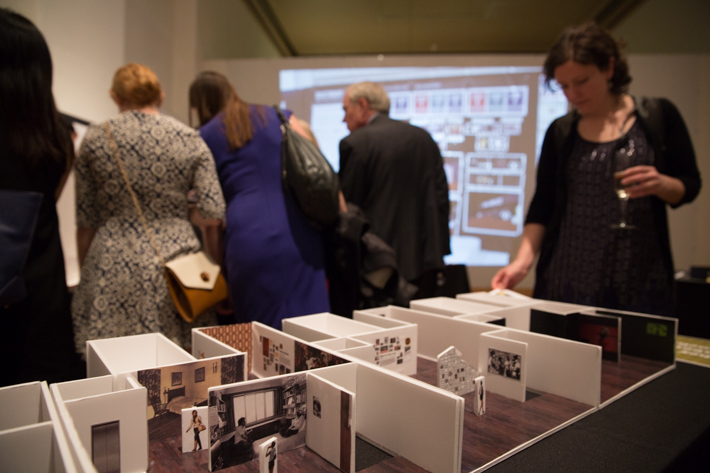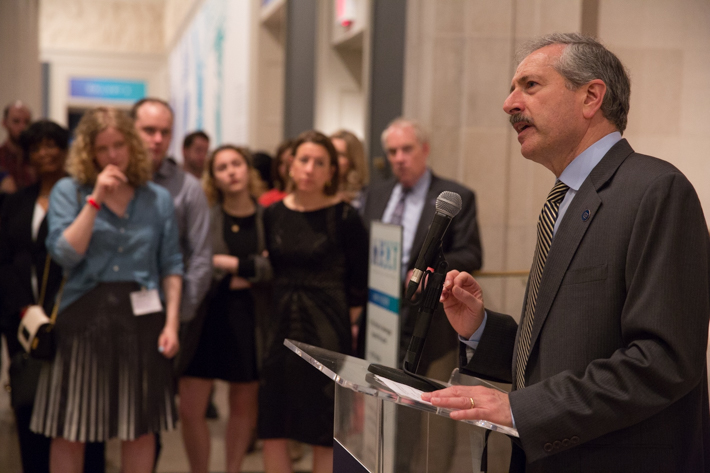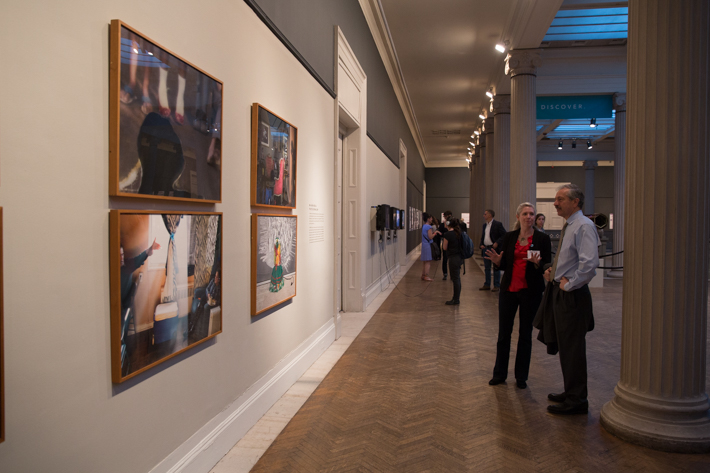M.A. candidate Ben Katz built an entire telescope from scratch this year. All of it—every last piece. The ultra-sleek reflective mirror? He spent about 40 hours grinding glass to get it perfectly smooth. The giant light bulb? He installed it himself. The massive, box-shaped mount? It required some dirty work, but yeah, he made that, too.
It’s really not that big of a deal, he said. He has handcrafted lots of things.
While living in Honduras a few years ago, he met a little girl who was paralyzed, and he promised her a wheelchair. When he couldn’t find one that could roll through the jagged streets of her rural village, he designed and constructed it himself.
So in some ways, he says, the telescope was actually a simpler project.
It attracted flocks of curious visitors Wednesday night when it debuted as part of Mr. Katz’s thesis project at the Corcoran School of the Art and Design’s annual NEXT graduate exhibition. Nearly 400 guests filled the 17th Street building to celebrate 63 M.A. candidates presenting their art to the D.C. community. The show followed an undergraduate exhibition that opened April 10 on the ground floor of the space.

The Corcoran School’s graduate students in interior design, art education, photojournalism and other programs have been finessing their thesis projects for more than a year. Mr. Katz’s own piece started when he was up on a roof, staring at the stars. He was trying to photograph them—not the easiest task in an urban city with skies caked in light pollution. So, he turned his gaze downward instead and noticed strangers walking along the streets of D.C., heads bowed toward the ground, deeply engrossed in their phones. He began snapping pictures.
“I was always trying to reconnect with humanity and to show how the progress we’ve made in space has direct implications on our daily lives,” he said. “The most demonstrative examples of that are actually our cell phones.”
In the exhibition, Mr. Katz positioned his telescope so that the lens aims toward his photographs hanging on a distant wall. On Wednesday, guests squinted into the telescope eyepiece and marveled at the expanded images of Mr. Katz’s mobile-obsessed passersby.
The interaction epitomized what Clare Brown, Corcoran assistant professor and program head of exhibition design, called one of the most energetic and positively received iterations of NEXT so far.
“People were exploring and reading all of the material we put up,” she said. ““It wasn’t just a social event—they were actually engaging with the art.”

Visitors hovered over a long blackboard in one part of the gallery, using chromatic markers to answer a short prompt: Best/worst museum experience? Memories of local and national museums filled the board in jagged handwriting. Throughout the room, exhibition design students showed off small replicas of museums they had envisioned for their own final projects. Graduate student Sarah Bordeaux had researched Washington’s Shaw neighborhood in the ’70s and designed a model of a community museum that would tell the area’s history.
People also circled around the building’s elegant rotunda, eyeing pieces from students in the Corcoran’s teaching and book arts programs. Teaching M.A. candidate Arnold Bigger’s project proved a quiet but impressive feat—he creased 1,528 pages to create a 3-D book sculpture boldly reading “NEXT 2015” in a proud ode to the Corcoran’s most distinguished student event.
The annual exhibition is one of the staples of the Corcoran, and GW is committed to supporting it, Provost Steven Lerman told students during opening remarks.
“As we look down the road, this is one of the things we have to preserve,” Dr. Lerman said. “It has to be a place that continues to create great artists and a place that nurtures them.”

The glossy photojournalism exhibitions lit the top floor of the exhibition with sharp, screaming color. Tiny Polaroids made up a crowded constellation of images in “Being Atticus Finch,” a project by new media photojournalism student Katie Nelson. The photos honor public defenders who represent roughly seven million people in the criminal justice system by catching the lawyers in their offices, at their most candid.
Not too far from Ms. Nelson’s project, graduate student Kara Frame displayed “I Will Go Back Tonight,” a photo series and short documentary chronicling the experience of Vietnam veterans living with post-traumatic stress disorder. Ms. Frame started the project for her father, who is a veteran, but the effort has since evolved into a broader look at the full effects of war. It also has been a litmus test for her ability as an artist and storyteller.
“It proved to me that I have what it takes not only to produce a documentary, but to put art on the walls that speaks to people,” she said.



